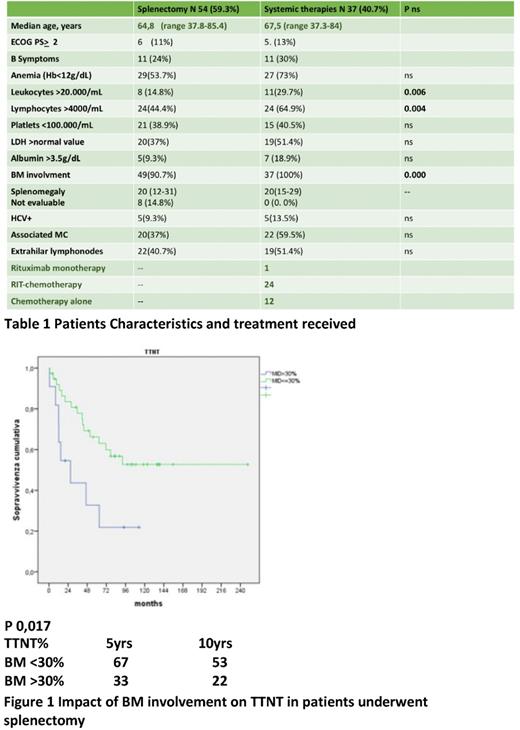Abstract
Introduction
The SMZL is a rare and indolent disorder that mainly affects elderly and middle-aged patients (pts). Therapy is indicated for constitutional symptoms, massive splenomegaly, or cytopenia and about one third of pts will never require therapy. In the past two decades, splenectomy has been progressively replaced by Rituximab (RIT)-based treatments (with or without chemotherapy) as the first line therapy in symptomatic SMZL. Long-term disease control is obtained in about 50% of pts with RIT alone and in 68% with chemotherapy-RIT combination, without significant difference in term of overall survival (OS) with the two approaches.
However, RIT monotherapy is not allowed in several Countries, including Italy. Furthermore, in the COVID-19 era, treatment with anti-CD20 showed a negative impact on the clinical outcome of infected pts, by limiting its recommendation.
In 2017 we published the experience of our Center in splenectomy as a front-line treatment of SMZL (Pata et al. Int Journal of Surgery 41, 2017), highlighting the feasibility and the few, acceptable adverse events related to the procedure.
We also reported a comparative analysis between pts who underwent splenectomy as the only first line approach and pts who were treated with systemic therapy (Pagani et al. Haemat 2015; 100 s3).
Here, we report long term results to verify the effectiveness of splenectomy as a first-line therapy in SMZL and to identify predictors of progression and the need for re-treatment.
Methods and patients
The retrospective analysis included all pts consecutively diagnosed and treated for SMZL at our Institution aged >18 years. Indications for treatment were symptoms related to splenomegaly or cytopenia due to hypersplenism. The choice of treatment was based on physician decision.
All pts who underwent splenectomy were vaccinated for encapsulated bacteria (Pneumococcus, Hemophilus Influenza B, and Meningococcus ACWY).
Response assessment was made as recommended by International Workshop criteria.
Survival analysis was performed with Kaplan-Meier method and univariate analysis with Log-Rank test with a significance at 0.05.
Results
From May 1997 to November 2014, 91 SMZL pts were treated. Of these, 54 underwent splenectomy (cohort 1) and 37 received systemic therapy (cohort 2). Pts characteristics and treatment received are shown in Table 1. Only leukocyte count and bone marrow (BM) involvement at diagnosis significantly differ in the two cohorts.
Overall response rate (ORR) was 91% in cohort 1, [5% complete remission (CR)] and 76% in cohort 2 (32% CR). Hematologic and nonhematologic side effects were acceptable and no treatment related mortality occurred in both groups, as already reported.
After a median follow-up of 102 months (range 1-275) 56% and 54% of pts progressed in cohort 1 and 2 respectively, p not significant (p ns).
Median time to next treatment (TTNT) was 77,3 months in cohort 1 and 128,1 months in cohort 2 (p ns), with 10-years (yrs) TTNT of 43% versus 58%, respectively.
Histological transformation occurred in 18% of pts in cohort 1 and 8% in cohort 2 (p ns).
The 10-yrs progression free survival (PFS) and OS were not significant different in cohort 1 and 2 (PFS 42% and 36% and OS 71% and 62%, respectively). In univariate analysis, within cohort 1, BM infiltration more or less than 30% had a significant impact on TTNT: median TTNT of 26,9 months with BM >30% versus not reached with BM <30%, with 10-yrs TTNT of 22% vs 53%, respectively (P 0.017). Figure 1.
Conclusions
With a long follow up, splenectomy is confirmed to be an effective alternative option to systemic treatment in SMZL. Moreover, in this pandemic period and especially in patient with low BM burden (infiltrate <30%), splenectomy should be considered as first line approach.
Disclosures
Tucci:Gentili: Membership on an entity's Board of Directors or advisory committees; Takeda: Honoraria; Kiowa Kyrin: Honoraria; MSD: Honoraria; Janssen: Membership on an entity's Board of Directors or advisory committees; Sanofi: Membership on an entity's Board of Directors or advisory committees.
Author notes
Asterisk with author names denotes non-ASH members.


This feature is available to Subscribers Only
Sign In or Create an Account Close Modal